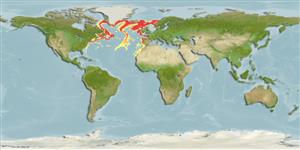Common names from other countries
>
Gadiformes (Cods) >
Macrouridae (Grenadiers or rattails)
Etymology: Coryphaenoides: Greek, koryphaina = dolphin fish + Suffix oides = similar to (Ref. 45335).
Environment: milieu / climate zone / depth range / distribution range
Écologie
marin bathypélagique; profondeur 180 - 2600 m (Ref. 58426), usually 400 - 1200 m (Ref. 1371). Deep-water; 73°N - 20°N, 77°W - 32°E
North Atlantic: from about 37°N to Baffin Island and Greenland in the western Atlantic, and off Iceland and Norway to 73°N to Barents Sea, south to North Africa in the eastern Atlantic. Reported to occur from the tongue of the Ocean east of Andros Islands (about 24°N, 77°W) in the Bahamas.
Length at first maturity / Taille / Poids / Âge
Maturity: Lm 52.7, range 60 - ? cm
Max length : 110 cm TL mâle / non sexé; (Ref. 35388); poids max. publié: 1.7 kg (Ref. 40637); âge max. reporté: 54 années (Ref. 41452)
Épines dorsales (Total) : 2; Épines anales: 0. Head broad, rather soft; snout broad, rounded, with a large blunt tubercular scute at its tip; chin with small barbel. Scales relatively adherent; spinules dense on body scales, long, thin and recurved, narrowly lanceolate, with longitudinal anterior concavity. Pyloric caeca 29 to 31, long and slender. Color medium brown to grayish; orbits, oral and branchial cavities, and fins blackish to brownish gray.
Benthopelagic to bathypelagic in about 400 and 1200 m depth. Minimum depth from Ref. 1371. Form large schools at 600 to 900 m depth (Ref. 9988). Feed on a variety of fish and invertebrates, but primarily on pelagic crustaceans such as shrimps, amphipods and cumaceans; cephalopods and lantern fishes constitute a lesser portion of the diet. Batch spawner (Ref. 51846). This species is currently facing overexploitation in the North Atlantic. Utilized frozen and for fishmeal; can be fried and baked (Ref. 9988).
Cohen, D.M., T. Inada, T. Iwamoto and N. Scialabba, 1990. FAO species catalogue. Vol. 10. Gadiform fishes of the world (Order Gadiformes). An annotated and illustrated catalogue of cods, hakes, grenadiers and other gadiform fishes known to date. FAO Fish. Synop. 125(10). Rome: FAO. 442 p. (Ref. 1371)
Statut dans la liste rouge de l'IUCN (Ref. 130435)
CITES (Ref. 128078)
Not Evaluated
Menace pour l'homme
Harmless
Utilisations par l'homme
Pêcheries: commercial
Outils
Articles particuliers
Télécharger en XML
Sources Internet
Estimates based on models
Preferred temperature (Ref.
115969): 2.7 - 9.4, mean 4.5 (based on 270 cells).
Phylogenetic diversity index (Ref.
82804): PD
50 = 0.5000 [Uniqueness, from 0.5 = low to 2.0 = high].
Bayesian length-weight: a=0.00219 (0.00111 - 0.00431), b=3.20 (3.03 - 3.37), in cm Total Length, based on LWR estimates for this (Sub)family-body shape (Ref.
93245).
Niveau trophique (Ref.
69278): 3.7 ±0.56 se; based on food items.
Résilience (Ref.
120179): Faible, temps minimum de doublement de population : 4,5 à 14 années (K=0.1; tm=9-11; tmax=54; Fec=10,000).
Prior r = 0.27, 95% CL = 0.18 - 0.40, Based on 4 full stock assessments.
Fishing Vulnerability (Ref.
59153): High to very high vulnerability (72 of 100).
Climate Vulnerability (Ref.
125649): Moderate vulnerability (38 of 100).
